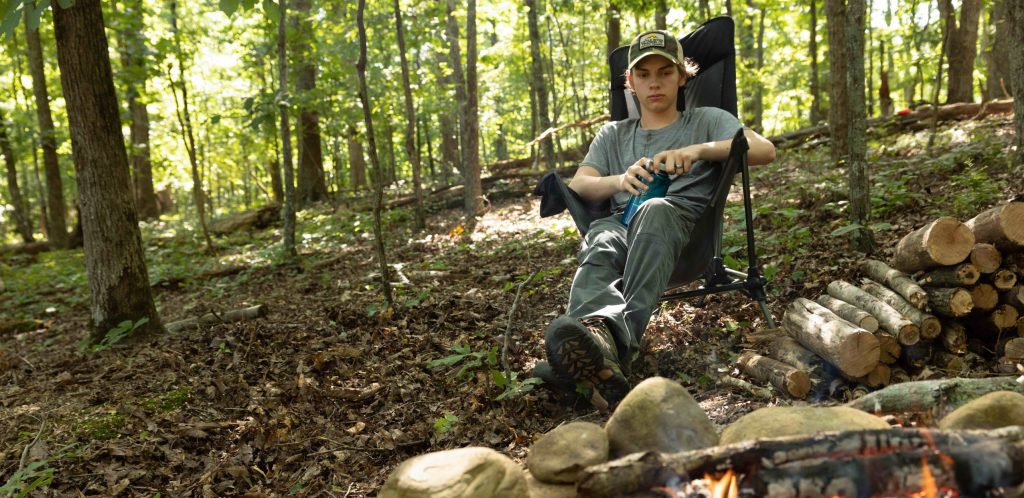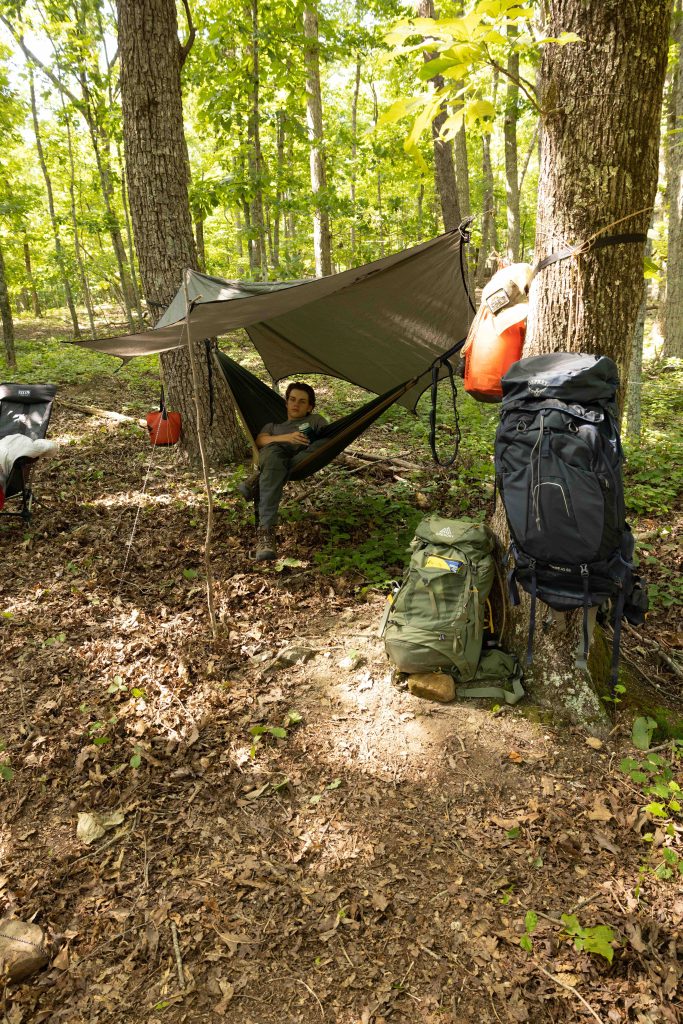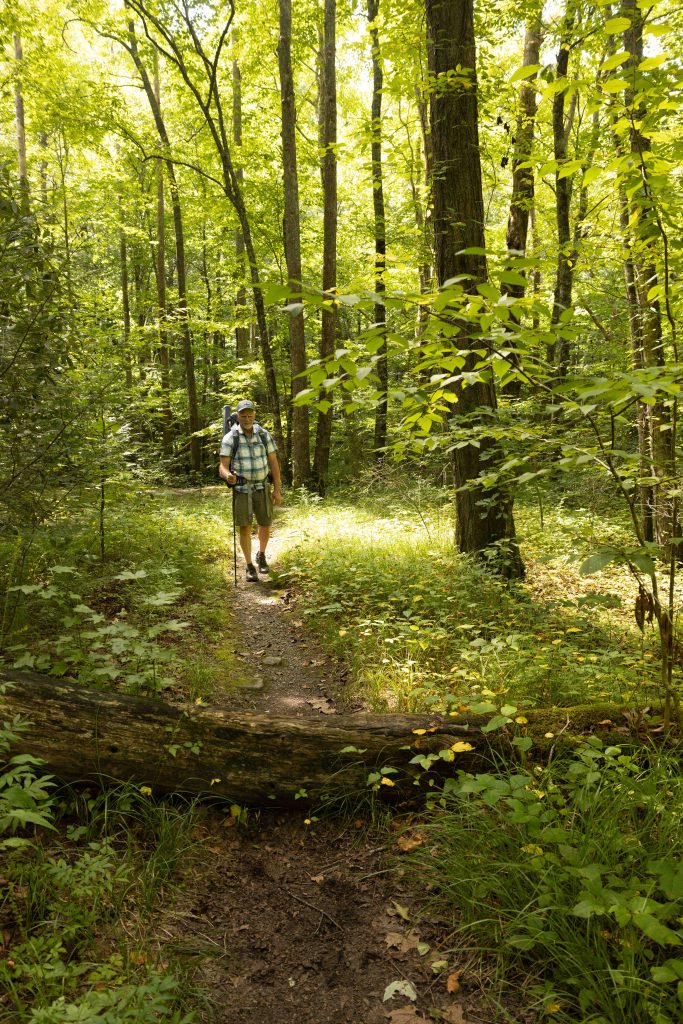No matter the season, getting off the beaten path and into the wilderness will heal your soul.
We have set up our campsite, and I am helping my son Troupe with the evening’s firewood collection. We are in the Smoky Mountains for a few days of camping and fly fishing.
As we gather wood for our fire, I explain what squaw wood is and why it can help get a fire going, especially in damp conditions. We have gathered a good bit of kindling—small twigs and some bark from an eastern red cedar. We eventually find some larger deadfalls for once the fire is properly burning. I tell Troupe that with a properly laid fire you should be able to start it with just one match. He looks doubtful but gives it a try and successfully lights it with a single match.
It’s always a great moment when you are able to share with your child some outdoor knowledge. As I watch Troupe continue to coax the fire, I am struck with thoughts of a trip in my early years during which being able to bring fire to life made a real difference. And as he ventures off to collect more firewood, I allow myself to get lost in the memory of that particular experience during my late teens and how critical it was to have some outdoor skills. As Troupe wanders around looking for more wood, I sit next to the fire and let the flames take me back to the mountains of decades past.

There was a time when the southern part of the country—occasionally even Knoxville—would see some significant snow. It was 1976, and as a Blue Ridge Mountain Sports sales rep, I was fascinated with everything outdoors. Almost every dollar I made went to purchase new equipment. From the latest climbing gear to the most innovative camping equipment, I was always all in. My goal at that time was to complete a multi-day winter backpacking trip in the Pisgah National Forest in North Carolina. When the day finally came, I was ready to roll, but the weather seemed to have other plans.
I walked outside only to be met with heavy snowfall. Who cares? I thought. It’s just a little snow. Perfectly capable of driving in these conditions, I set off towards Asheville. My trusty steed—none other than a cherry red 1967 Opel Kadett Station Wagon—was well-equipped with a new set of snow chains, just in case. I felt unstoppable.
However, the further I got up into the mountains, the worse it got. Traveling along Interstate 40, the plows couldn’t keep up, and the little traffic there was had slowed to under 30 miles per hour. I knew how late I would be to meet my friends and feared they would leave without me and I’d have made the trip—and prepared for months—for nothing.
Angry and somewhat desperate to make up time, I studied my small folding road map and spied what looked to be a possible shortcut across US 276, an almost straight line from where I was to my destination. It seemed too good to be true, but I was game. The map was so small, however, that the switchbacks were not clear, and in my anxiousness, I completely missed that it crossed the Blue Ridge Parkway at just over 5,000 feet above sea level.
I made it for a few miles down the two-lane road, but knew trouble lay ahead when the mountain loomed up in the windshield.
Pulled over on the side of the road, knee-deep in snow, I worked furiously at getting the chains on my tires. As I spotted a snow plow coming down the road, I thought, What luck! Just in time. But as he passed me and began up the mountain, I watched in disbelief as he lifted his plow blade, leaving the road covered with over a foot of fresh snow. This was the bottom of the mountain, and conditions would certainly worsen the farther up I’d go. I took a run at it, but was stuck in less than 1,000 yards. Pulling out a shovel, I began to dig myself out, convinced the opportunity for the trip had been missed.
But as occasionally happens in those moments, lady luck came to the rescue in the form of a large motor-grader making its way towards me, plowing the road as he came. The grader stopped beside me, and a grizzled old fellow with a quizzical look of disbelief on his face stepped out from the cab. “Are you trying to make it over this mountain in that thing?” he asked with a smirk. Quickly explaining my plight, I asked for his suggestion. “Hold on a minute,” he twanged, and with that, he dragged out a heavy chain and instructed me to hook it to my frame under the front bumper. No convincing was necessary on my part. Chain attached. “What’s next?” I asked.
“Just keep it neutral and try your best to steer right behind me,” he replied. “I will pull you to the top of the mountain, and then you are on your own.” This might work out, after all, I thought. “You won’t have a problem after that,” he said. “I heard on the radio that they have already plowed the North Carolina side.” The journey up the mountain was bumpy, but we made it to the top. What a relief.
True to his word, the North Carolina side was clear, and somehow I made it to my friends just in time. I felt like I had already had a first-class adventure, and this was going to be a two-fer for sure. We grabbed our packs, strapped on our boots and gaiters, and off we went.
The falling snow was gorgeous as we made our way to our first campsite, roughly six or seven miles up the mountain. About dusk, the sky cleared for a fantastic star show, but with the clear skies came plummeting temps, and we struggled to stay warm, aided only by a large fire. Eventually with boots and water bottles into the foot of our sleeping bags—an old mountaineer’s trick to avoid having frozen boots in the morning—we went to bed, hoping the sunrise would bring some respite from the cold.
The following day was bitter cold. Our gear was good but not perfect, and I was having a tough time getting warmed up. I don’t think I felt my fingers until we got packed up and moving. The nearly 18-inch-deep wet, cushy snow of yesterday was now piled into drifts crusted over on the top making it difficult to navigate without snow shoes. It was a lesson learned about the value of truly understanding what you need to be both safe and comfortable on an outdoor excursion. And it is one I will never forget.

When the idea of a backpacking trip came up this summer, I knew the first thing I needed to do was update my backpacking gear. I was about to embark on a multi-day excursion with my 15-year-old son and despite the fact that it had been more than 40 years since that snow-capped few days on the mountain, that feeling of being ill-equipped for what lay ahead was frozen in my mind. So I started with a trip to Little River Trading Co. in Maryville to see what they would recommend in the way of a gear update.
Little River has a great selection of pretty much everything you might need for this kind of trip. The staff was super helpful in getting us correctly sized for our new packs, and I have to say that today’s packs are much better engineered than those of my days at Blue Ridge. Gone are the days of the external frames, now replaced by perfectly fitted ergonomic internal frames with easy top and bottom access and built-in water reservoirs. Troupe ultimately chose a Gregory Paragon 58, selected for its lightweight nature, and I went with an Osprey Atmos AG 65, also lightweight but with side pockets perfect for my tiniest of cameras. An excellent suggestion was to pack everything in waterproof stuff sacks. That way, things lying around the camp would stay dry even out of the pack. So we made sure to pick up a half-a-dozen Sea to Summit eVac Dry Sacks of varying sizes.
We decided to forego tents and instead chose to use ENO hammocks and rain flys. This meant we could camp almost anywhere without worrying about water in the tent. These hammocks make even the best sleeping pad seem uncomfortable. I’ve been using one for quite some time and love being able to set it up right next to a stream to enjoy the sound of running water.
Clothes can make a difference in how much you enjoy your adventure. Modern outdoor clothing is quick-drying and most incorporate some level of stretch for comfort—quite an upgrade from years past.
The Little River staff recommended KÜHL Radikl and Prana Stretch ReZion pants and shorts. Patagonia’s Tech Web belts and Capilene Cool sweat-wicking shirts made our short list as well.
We coupled our attire with, in my opinion, the best outdoor footwear out there. My all-time favorite boots are from Keen Footwear, and Troupe and I both opted for the Targhee Vent Mid Height. We couldn’t have made a more ideal choice.
It might seem like a secondary thought, but good socks are essential for any sort of outdoor adventure. I prefer Smartwool or Darn Tough; they never let me down. Even with perfect boots and socks, a pack of moleskin for blisters are an essential addition to the first aid kit.

A final check of my old gear made me realize I needed a new cook set and stove. If I learned anything from the many canoe trips with my dad as a teen, it’s that campsite cuisine is an important part of any overnight outing, and although I personally prefer a campfire, that just isn’t always possible. By either campfire or stove, I was determined to share with Troupe one of my favorite parts of camping, shared with me when I was his age. I knew how good it would feel to pass down a tradition to my son which my dad passed down to me.
So we headed out to River Sports Outfitters in Knoxville for a lesson in modern camp cook gear. Ultimately, we went with a Mountain Safety Research stove and cook set, selected for its ability to use regular auto gas. The perfect update from my old SVEA stove.
For Troupe and me, no trip is complete without a little fishing. Syndicate fly rods are perfect for Smokies stream fishing. You can pick one up at 3 Rivers Angler in Knoxville, and while you’re there, find out what flies you will need.
The final piece of preparation was simply selecting our locale. We drove to the top of Treemont Road and set off from there. If you are new to backpacking, I highly recommend Johnny Molloy’s Backpacking Tennessee guidebook. Johnny has spent more than 2,500 nights on the trail and is, in my opinion, our area’s consummate authority on hiking in the southeast region. He’s the real deal.
After Troupe came back with arms full of firewood that first day, we spent the rest of the evening just enjoying the sounds of nature, as we fed the campfire, occasionally swapping a story. I always relish the time spent outdoors, and this trip felt particularly gratifying to be with my son.
The outdoors does something special to you. When given the chance, it can catapult you deep into thought, its sounds and smells often causing you to become lost in memories from hikes or trips past. But it can also find you more present than our usual lives often allow. And with the right gear, exceptional company, and a willingness to just be, the outdoors can be a haven for all who make an effort to get to know it.

Comments are closed.